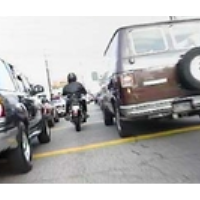How Will Grandma and Driverless Cars Handle Lane-Splitting When It’s Explicitly Legal?

Google’s autonomous cars, being tested on roads around the state, are already said to “drive like your grandma,” so it should be interesting when motorcycles get the official legislative green light to split lanes with impunity. That could be very soon.
The state Assembly passed legislation last week that would give an official nod to a practice explicitly illegal in the other 49 states, but unofficially tolerated in California. Under the law, motorcyclists could drive between lanes as long as they were traveling under 50 mph and don’t exceed the speed of cars by 15 mph.
Lane-splitting—otherwise known as white-lining, filtering and lane-sharing—is a time-honored tradition on California roads, with unofficial guidelines (pdf) approved of by the California Highway Patrol (CHP).
Although there is an army of gesticulating angry and frightened motorists who think the sudden appearance of a human form clinging to a vehicle streaking inches from their own is unsafe, a study (pdf) from the University of California, Berkeley, asserts otherwise.
An analysis of data from the California Enhanced Motorcycle Collision Data Project found that 997 of 5,969 motorcyclists (17%) involved in accidents that were surveyed between June 2012 and August 2013 were lane-splitting. By and large, “Lane-splitting appears to be a relatively safe motorcycle riding strategy” if CHP guideline speeds are observed, the report said.
Despite the “relatively safe” pronouncement, the researchers admit that they could not properly compare lane-splitters to non-lane-splitters based on available data. “The collection of these data is fraught with problems, and the current study did not attempt to collect such data,” the report said.
What the researchers could discern was that when lane-splitters weren’t driving like maniacs, they were better at avoiding serious injury than non-splitters:
“Lane-splitting riders were less likely to suffer head injury (9% vs 17%), torso injury (19% vs 29%), extremity injury (60% vs 66%), and fatal injury (1.2% vs 3.0%). Lane-splitting motorcyclists were equally likely to suffer neck injury, compared with non-lane-splitting motorcyclists.”
That may have something to do with their riding habits. “Lane-splitting motorcyclists were more often riding on weekdays and during commute hours, were using better helmets, and were traveling at lower speeds.” They were also less likely to have been drinking and carrying a passenger.
The speed of the motorcycle has a lot to do with safety of the vehicle, and it most commonly comes into play when a motorist changes lanes near it. But other hazards related to speed include speed bumps, uneven pavement and door openings from parked cars.
“Surprisingly, we found that the difference in speed between the motorcycle and the surrounding traffic was a bigger predictor of injury than speed alone,” according to the study’s lead author, Thomas Rice. “Above a 15-mile-per-hour speed differential, the risk of injury rose significantly.”
A 2014 UC Berkeley study found lane-splitting is widespread in California. The survey found that 80% of 951 motorcyclists said they lane-split at least some the time on freeways and 37% said they always did it. The survey also found that other motorists hate it. Sixty-one percent “somewhat” or “strongly” disapproved of lane-splitting.
Thirty-six percent of the motorists thought it was illegal. They were wrong.
–Ken Broder
To Learn More:
Lane-Splitting for Motorcycles Is Safe, Says Landmark Berkeley Study (by Charles Fleming, Los Angeles Times)
Yes, We Should Let Motorcycles Ride Between Cars (by Alex Davies, Wired)
Motorcycle Lane-Splitting Bill Passed by California Assembly (by Gary Richards, San Jose Mercury News)
Is Motorcycle Lane-Splitting Safe? New Report Says It Can Be (by Sarah Yang, UC Berkeley news center)
A California Resident Says Google's Autonomous Cars “Drive Like Your Grandma” (by Joseph Stromberg, Vox)
Motorcyclists Who Want to Split Lanes Should Drive Slow and Not be Old (by Ken Broder, AllGov California)
Motorcycle Lane-Splitting and Safety in California (by Thomas Rice, Lara Troszak and Taryn Erhardt, Safe Transportation Research & Education Center University of California, Berkeley) (pdf)
- Top Stories
- Controversies
- Where is the Money Going?
- California and the Nation
- Appointments and Resignations
- Unusual News
- Latest News
- California Forbids U.S. Immigration Agents from Pretending to be Police
- California Lawmakers Urged to Strip “Self-Dealing” Tax Board of Its Duties
- Big Oil’s Grip on California
- Santa Cruz Police See Homeland Security Betrayal in Use of Gang Roundup as Cover for Immigration Raid
- Oil Companies Face Deadline to Stop Polluting California Groundwater





